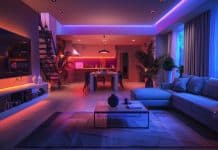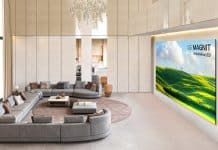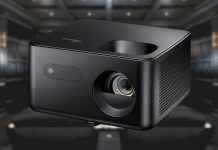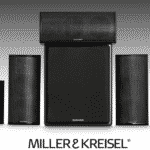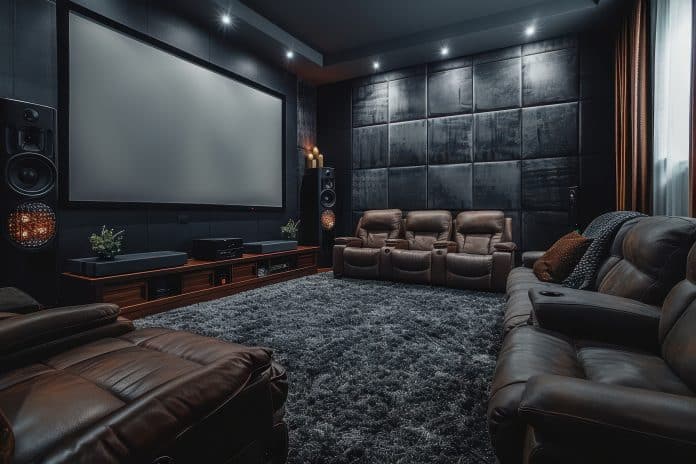
An overview of the newest innovations and tech upgradations in home entertainment reveals how AV brands and system integrators are transforming living spaces. With advancements in spatial audio, 8K projection, and intelligent automation, theatre-like experiences are now a reality at home.
The way we experience entertainment within our homes has undergone a drastic change. What was once limited to a flat-screen television and a surround-sound system has now expanded into immersive, multi-sensory environments—thanks to the collaboration between AV brands, System Integrators, and Design Professionals. Today, home entertainment is no longer just about watching movies or listening to music; it is about creating experiences similar to commercial theatres and concert halls, right at your home.

Several factors are driving the emergence of this new entertainment ecosystem, and at the forefront are Audio-Visual (AV) brands that continue to push the boundaries of technology. For example, Spatial audio is advancing beyond traditional stereo and surround sound to deliver immersive, three-dimensional soundscapes. 8K resolution and laser projection have introduced ultra-high-definition visuals with breathtaking clarity and HDR precision, while AR/VR integration extends entertainment beyond the screen into interactive, immersive worlds. Adding a layer of intelligence, AI-powered automation learns user preferences and seamlessly adjusts sound, lighting, and visuals to suit moods and routines. Enhancing this ecosystem further is high-fidelity streaming, which transforms digital content into audiophile-grade experiences—proving that convenience and uncompromising performance can coexist.
Modern homeowners no longer want bulky equipment or clunky setups. They demand design-led integration—hidden speakers, automated lighting, acoustically treated rooms, and user-friendly control systems. This is where System Integrators become the bridge, ensuring that high-performance AV technology blends effortlessly with the overall interior design of a home.
From Luxury to Lifestyle
Just a decade ago, home theatres and high-end AV setups were reserved for luxury homes. Today, these solutions are becoming increasingly mainstream. Mid-segment residences and apartments are adopting modular home theatre kits, wireless multi-room audio, and smart projectors. Brands and integrators are responding by offering scalable solutions, ensuring that a compact city apartment can enjoy the same immersive experience as a sprawling villa, albeit on a different scale.
Architects and interior designers now work hand-in-hand with System Integrators to ensure that spaces are acoustically optimized and technologically future-ready. Walls are no longer just walls; they can double up as projection surfaces. Ceilings can be fitted with invisible speakers. Lighting can sync with the mood of the movie, and voice commands can instantly transform a living room into a mini-cinema.
For homeowners who are keen on adopting these advanced systems, they depend on system integrators to recommend the right mix of products and ensure that technology doesn’t overwhelm the homeowner but enhances their lifestyle seamlessly.
In an exclusive interaction with Smart Home World, some of the top System Integrators and Brand Heads share insights on the latest trends and innovations.
Mehernosh Pervez, Founder, Sound Decisions

What trends are you seeing in client requests for home cinema — dedicated theaters vs. multipurpose media rooms?
Over the past few years, we’ve seen a noticeable shift. Earlier, most clients came to us wanting large, dedicated home theaters with closed rooms, tiered seating, and complete blackout environments. That remains popular among pure movie lovers, but it is no longer the only dream setup.
Many high-end homeowners are now leaning towards multipurpose media rooms. They want spaces that look elegant during the day yet transform into a cinematic experience at night. It is about flexibility, so we believe having one room that works for family gatherings, casual viewing, and high-performance movie nights is a change in dynamic that has been seen over the years. In the luxury segment, aesthetics are a priority. Clients do not want bulky speakers or visible wires; they want everything integrated, whether that means hidden speakers, motorized screens, acoustic treatments that double as decor, or lighting scenes that shift with the mood. If I had to choose one format based on current demand, multipurpose media rooms are leading the trend.
How do you approach acoustic treatment and speaker placement in architecturally complex homes?
In architecturally complex homes, we work with the space rather than against it. Speaker placement is all about precision and planning. We position speakers to complement the room’s shape and layout, ensuring optimal coverage and accurate imaging from every seat. Early coordination with architects is key, allowing us to conceal wiring, recess speakers, and integrate subwoofers without disturbing the design.
What’s your preferred ecosystem for integrating AV with lighting, shading, and automation?
For most of our high-end projects, our preferred choice is Savant and Raylogic. It is the same system we have in our own home, so we have firsthand experience of how seamless and intuitive it is. They both bring AV, lighting, shading, and climate control together in a single, elegant interface, with custom scenes that can transform a space instantly. The automation is smooth, the app is highly responsive, and with one tap, you can set the perfect mood for a movie night.
How do you manage calibration for projectors, audio tuning, and control interfaces to deliver a true cinema-like experience?
Calibration is where everything comes together. For projectors, we use professional calibration tools to fine-tune brightness, contrast, sometimes colour accuracy, and HDR so the visuals match the filmmaker’s intent. Audio is tuned with precision by adjusting speaker levels, delays, and EQ to suit the room’s acoustics, ensuring balanced, immersive sound in every seat. Control interfaces are tailored to the client, with their most-used functions front and centre, and pre-programmed scenes ready at a touch. This creates a consistent, cinema-grade experience every single time.
Can you share a project where you had to overcome a unique challenge to deliver a premium AV setup?
One standout project was a luxury penthouse in Malabar Hill, Mumbai, with floor-to-ceiling glass on three sides. The space was acoustically challenging, with many reflective surfaces, minimal wall space for speakers, and almost no options for hiding wiring. We collaborated closely with the architect to integrate in-ceiling directional speakers, custom low-profile subwoofers, and discreet acoustic treatments that merged perfectly with the interiors. For projection, we chose a high-brightness laser projector paired with an ambient light-rejecting screen to ensure crystal-clear daytime viewing. Every element, from speaker angling to automation scenes, was fine-tuned on-site. The result was a seamless, cinema-grade experience in a space most people thought would never work for serious AV.
Manoj Soni, Founder, AV4U

What trends are you seeing in client requests for home cinema — dedicated theaters vs. multipurpose media rooms?
The market has moved beyond a simple choice between a dedicated theatre and a multipurpose media room—it’s now about `experience-first design’ that reflects each client’s lifestyle. One of the biggest trends shaping this shift is hybrid spaces: rooms that seamlessly transform from a relaxed family lounge into a reference-grade cinema at the touch of a button. With advancements in display technology, acoustical treatments, and motorized concealment systems, the line between “dedicated” and “multipurpose” is rapidly disappearing. The true challenge—and opportunity—lies in striking the right balance between technology, design, and lifestyle, ensuring the space delivers that wow factor whether it’s for a blockbuster movie night, a live concert stream, or watching the big game in broad daylight.
How do you approach acoustic treatment and speaker placement in architecturally complex homes?
Speaker placement and acoustics often present the biggest challenges in architecturally complex homes, where designers prefer hidden solutions over conventional speakers or visible treatments. To address this, we follow a two-tier approach. First, we recommend the most technically suitable speaker options that blend seamlessly with the design aesthetic while ensuring minimal compromise on performance. Second, to achieve the desired acoustic parameters, we encourage the use of natural design elements—such as curtains, fabric in seating, and wall paneling—that enhance sound quality while maintaining visual harmony. Additionally, we conduct regular CEDIA-accredited CPD programs, which serve as an effective platform to update designers on the latest technology trends and to foster deeper collaboration.
What’s your preferred ecosystem for integrating AV with lighting, shading, and automation?
Our priority is ecosystems that work flawlessly and stand the test of time, and we make it a point to keep clients and designers educated on emerging trends.
How do you manage calibration for projectors, audio tuning, and control interfaces to deliver a true cinema-like experience?
At AV4U, we have state-of-the-art calibration equipment and in-house skill sets like ISF/HAA/THX certifications. We also use the most recent recommended practices, like CEDIA RP-22, to deliver the entertainment experience as the director intended.
Can you share a project where you had to overcome a unique challenge to deliver a premium AV setup?
We recently completed a project where the client envisioned transforming a spare room into an immersive entertainment space featuring a fully automated 4K system with Dolby Atmos 7.1.4 surround sound. However, upon reviewing the initial drawings, we realized that the room’s narrow width was a significant limitation for achieving true cinematic immersion.
After several rounds of discussions—and a few heated debates—with both the client and the architects, we were able to convince them to implement critical modifications in the construction. By reworking the dimensions to increase both the width and ceiling height, and by integrating a hidden, customized projector housing with automation, we successfully elevated the space to meet the desired performance standards while staying true to the design intent.
The result was an entertainment room that not only met but exceeded expectations. Both the client and the architect were delighted with the final outcome—a perfect blend of aesthetics, technology, and immersive experience.
Fenil Mehta, Founder, White Noise (Integration Company & Sound Tight (Manufacturer of Sound Proofing Elastomers )

What trends are you seeing in client requests for home cinema — dedicated theatres vs. multipurpose media rooms?
The line between a dedicated home cinema and a media room is getting blurred as the quality of AV equipment and expertise of the Integration Industry is getting better each day. The design and build community has adapted well to technology and is better poised to provide a complete and entertaining experience to the client.
It generally boils down to the way a space is aesthetically and acoustically treated, with a formal cinema style or an informal living room style layout. Essentially, the AV system is what merges the functions of these spaces and allows one to have great entertainment in any scenario.
How do you approach acoustic treatment and speaker placement in architecturally complex homes?
Acoustics is the most misunderstood, misinterpreted, and in a lot of cases, an ignored subject. The design and build community, as well as the integration industry, are fairly unaware, misinformed and misled by half-baked knowledge of acoustics available on the web. A lot of material manufacturers that promote their materials as acoustic blinds, acoustic ceiling, acoustic panels, acoustic paint, etc., are adding to this confusion. Many such manufacturers mislead the design community with graphs and numbers like NRC & STC.
One needs in-depth knowledge about material sciences and physics, backed by simulation software and acoustic calculation software to give an optimized acoustic solution.
Usually, a designer or a client comes to an acoustic consultant after a complex space has been built; This needs to change. For architecturally complex spaces, it becomes important for the architect to involve an acoustician from the very beginning of the architectural design process. As the great architect and designer Louis H. Sullivan said of his design philosophy, `Form follows Function’. When it comes to acoustics and aesthetics in complex spaces, we need to achieve a very rare occurrence; one that’s difficult to achieve – `Form marries Function’.
What’s your preferred ecosystem for integrating AV with lighting, shading, and automation?
There are cases where certain clients want the highest level of integration and there are cases where clients still prefer the conventional handheld remote and physical switches. Although our personal preference here would be a well-designed system that is user-friendly, one that requires the least intervention and one that the grandmother as well as the granddaughter can use. A lot of brands and ecosystems are able to achieve a similar result; it all depends on how the integrator understands a client’s requirements and designs a solution around the client’s lifestyle.
How do you manage calibration for projectors, audio tuning, and control interfaces to deliver a true cinema-like experience?
These days, AV equipment comes with either a 3rd party calibration software or a proprietary calibration software. These are fairly easy to use as long as one knows what one is aiming to achieve. There are some free software as well, where you would just need a good microphone along with its calibration file, and a laptop with some cables, and an experienced integrator who has trained eyes and ears can manage to achieve fairly good sound.
For Video calibration, there are various software’s that are available in the market. One will need a good colorimeter, a spectrometer, and a pattern generator that is compatible with the equipment and the software.
There are certification courses that are conducted on a regular basis in the industry that greatly elevate the calibration skill set of integrators. For ex. HAA, THX, ISF, PVA etc.
Rishabh Jain, Director, Audio & Beyond

What trends are you seeing in client requests for home cinema — dedicated theaters vs. multipurpose media rooms?
We’re increasingly seeing a shift towards multipurpose media rooms, especially in urban homes where space is premium. Clients want flexibility — a living room that transforms into a home theatre in seconds. However, for luxury homes or second properties, dedicated cinema rooms are still in demand, especially where immersive audio and large-format projection are priorities. Clients are looking for not just performance, but aesthetics and ease of use.
How do you approach acoustic treatment and speaker placement in architecturally complex homes?
Each space is unique, and so is our approach. We begin with a detailed site survey and simulation, taking into account materials, dimensions, and listening positions. Acoustic treatment is always subtly integrated into the design to maintain the interior language. For speaker placement, we rely on a combination of acoustic modeling, in-room measurements, and real-time calibration. For larger or more open spaces, directional speakers and zoning help control audio spill and improve clarity.
What’s your preferred ecosystem for integrating AV with lighting, shading, and automation?
We prefer IP-based control systems that offer flexibility and scalability. Our go-to ecosystems include KNX for lighting and HVAC, Lutron for lighting and shading control, and Control4, Savant and Casadigi for complete AV integration. These platforms ensure seamless control via mobile, touch panels, or voice, while maintaining reliability and future-proofing.
How do you manage calibration for projectors, audio tuning, and control interfaces to deliver a true cinema-like experience?
Calibration is critical. For video, we follow ISF-certified calibration standards, adjusting brightness, colour temperature, and sharpness based on ambient light conditions. For audio, we use reference microphones and DSP-based tuning, ensuring accurate imaging and immersive surround. Control interfaces are designed to be intuitive, often with scene-based automation for a single-tap “Movie Mode” experience.
Can you share a project where you had to overcome a unique challenge to deliver a premium AV setup?
One of our most exciting and challenging projects was the experience theatre we built for the Charcoal Project, Hyderabad. The room itself was unusually large and abstract in shape, which made traditional AV design approaches impractical. Instead of opting for a standard projection setup, we chose to go with an active LED video wall — a bold move that ensured brightness, clarity, and a seamless cinematic experience regardless of ambient light.
For audio, the irregular shape of the room made Trinnov’s advanced room correction system the ideal choice. The Trinnov processor adapted brilliantly to the space, delivering precise, immersive sound that elevated the experience. On the video front, we integrated MadVR for video processing, which ensured full-screen playback with true HDR — every single time.
Adding to the complexity was the design aspect — the room was conceptualized by the renowned Mrs. Gauri Khan, whose aesthetic vision had to be preserved meticulously. This meant we had to strategically conceal all speakers and AV components without compromising on performance. The final outcome was a stunning blend of design and technology — a true showcase of what’s possible when form and function come together seamlessly.
Ajay Kamath, Founder & Principal Consultant, SOUNDS GOOD
What trends are you seeing in client requests for home cinema — dedicated theaters vs. multipurpose media rooms?
While clients do gravitate towards dedicated theater rooms that replicate the look, feel, and immersive experience of a commercial cinema, such lavish spaces are often a luxury even for premium apartment buyers in cities like Mumbai. As a result, we frequently design multipurpose media rooms that double as a living room, den, or guest bedroom and can transform into a high-performance cinema at the touch of a button. Interestingly, we’re also seeing a surge in holiday homes where space is less constrained. These clients are more than happy to dedicate generous real estate to create grand, fully equipped theater rooms.
How do you approach acoustic treatment and speaker placement in architecturally complex homes?
There’s no one-size-fits-all solution when it comes to acoustics. Beyond the structure and dimensions of the space, we also take into account the interior materials and finishes envisioned by the designer. With this information in hand, we integrate acoustic treatments that effectively address audio challenges while blending seamlessly with the interior design. Fortunately, modern acoustic materials have evolved to visually mimic traditional finishes — today, you can get high-performance panels that look like marble, brick, or wood, allowing us to maintain both form and function.
What’s your preferred ecosystem for integrating AV with lighting, shading, and automation?
For projects that feature extensive AV equipment and require advanced integration with lighting, shading, HVAC, and other systems, we deploy a custom-designed control solution tailored to each site. This gives us maximum flexibility, reliability, and the ability to create an intuitive user experience that works flawlessly.
How do you manage calibration for projectors, audio tuning, and control interfaces to deliver a true cinema-like experience?
After delivering thousands of projects, this process has become second nature to me. There have been numerous instances where clients were struggling with systems that other integrators couldn’t get right — and I’ve been able to resolve everything and walk out in under an hour. It’s all about in-depth understanding, experience, and attention to detail. Whether it’s video calibration, fine-tuning surround sound, or designing intuitive control interfaces, every element is precisely optimized to recreate the cinematic experience as intended by the creators.
Can you share a project where you had to overcome a unique challenge to deliver a premium AV setup?
We recently completed a project at the residence of a celebrated architect. While not a challenge in the conventional sense, the client had one clear and valid demand: no visible equipment. And rightly so — it’s a stunningly designed home where the interiors deserve to take center stage.
To achieve this, we used a motorized projector lift and retractable screen, with all nine Dolby Atmos speakers (plus a second zone) embedded in the ceiling to stay out of sight. Even the four subwoofers were ceiling-mounted — a rare feat. The result is a space that transforms from a regular-looking living room into a full-blown cinematic environment with a 130-inch screen and truly explosive sound, all without disrupting the visual aesthetics of the room.
Insights from Brand Heads
Rajeev Singh, Managing Director, BenQ India and South Asia,
How is your brand adapting to the demand for custom-installed solutions in high-end residential spaces?
BenQ has been proactively evolving its product portfolio and integration approach to cater to the growing demand for custom-installed AV solutions in India’s premium residential and commercial segments. we’ve seen a clear shift in luxury residences where homeowners and architects increasingly want technology that blends seamlessly into bespoke spaces. Our portfolio of high-end projectors—including the Laser & LED Series—has been designed with this in mind. These solutions combine discreet installation flexibility, superior brightness, and advanced colour accuracy, making them ideal for private home theatres, entertainment lounges, and even multi-purpose living areas. We also work closely with architects, interior designers, and system integrators to provide custom-install support—from consultation to calibration—ensuring the technology doesn’t just deliver cinematic performance but also complements the aesthetics of luxury interiors. In essence, we’re adapting by offering tailored experiences—solutions that integrate into the design vision while elevating the lifestyle value of high-end homes
Are Indian consumers more aware now of the value of room acoustics, calibration, and proper amplification?
In recent years, awareness has grown significantly in India over the past few years. As more homeowners invest in luxury home theatres and high-end entertainment zones, they’re realizing that picture quality alone isn’t enough—the entire ecosystem matters.
We see consumers asking the right questions around projector placement, calibration, and colour technologies to ensure they get the full cinematic experience. A lot of this is driven by exposure to global trends, travel, and the growing influence of architects and system integrators who highlight the role of design and technology together.
At BenQ, we actively support this shift by providing tools like ISFccc-certified calibration and HDR tone mapping, which allow precise fine-tuning to the room environment. This way, customers don’t just buy a projector; they enjoy a complete, properly optimized theatre experience at home.
What innovations have you launched recently in areas like immersive audio (Dolby Atmos, DTS: X), streaming integration, or control systems?
At BenQ, our recent innovations are centered around creating a truly seamless, future-ready entertainment experience. A big focus has been on streaming integration—our latest projectors come with Google-certified Android TV built in, giving users direct access to Netflix, Prime Video, Disney+ Hotstar, YouTube and more, without the need for external devices. This makes the system cleaner, faster, and more intuitive for both homeowners and integrators.
We’re also embracing AI-driven enhancements. For example, our projectors use AI-powered HDR tone mapping and upscaling to automatically adjust picture quality scene-by-scene, ensuring the visuals are always optimized for the content being watched. This removes the complexity of manual adjustments and delivers a consistent, premium viewing experience.
By combining smart streaming, AI-based picture intelligence, and integration-ready designs, we’re helping high-end residential spaces achieve both convenience and performance at a luxury level.
How are you working with system integrators and architects to ensure your products are seamlessly embedded into the design phase?
At BenQ, we understand that in luxury residences, technology has to blend into the design vision while delivering uncompromised performance. That’s why our collaboration with system integrators and architects begins early—with experience zones and walkthroughs that help them visualize how our solutions fit into bespoke spaces.
We also invest heavily in partner training programs, equipping integrators and consultants with in-depth knowledge of projector installation, calibration, and integration with automation systems. This ensures they can confidently recommend and deploy BenQ solutions that meet both technical and aesthetic requirements.
Our premium range is supported by various ports that can be connected to the high-end AV Systems. In short, we’re not just providing products; we’re building an ecosystem of trained experts and experiential showcases that ensure BenQ technology becomes a natural extension of the architectural story.
What’s your outlook for the growth of multi-room, invisible audio, and voice-controlled AV setups in India?
BenQ sees the next phase of India’s luxury home AV market being defined by truly integrated visual experiences across spaces. Architects are increasingly drawn to discreet projection setups—hidden mounts, ultra-short-throw solutions, and design-friendly finishes—that allow immersive visuals without visible hardware intrusion.
Voice control is also playing a growing role in video experiences. With compatibility for Google Assistant, Alexa, and leading automation platforms, BenQ projectors can be controlled through simple commands—whether it’s starting a movie, dimming the lights, or switching inputs—making the system intuitive for all family members.
With the convergence of multi-room video, hidden installation, and voice-enabled control, we believe India’s luxury AV market is poised to deliver cinema-grade immersion that feels natural, effortless, and beautifully designed.
Sanjay Chawla, Managing Director, Kripa Electronics India Pvt. Ltd
How is your brand adapting to the demand for custom-installed solutions in high-end residential spaces?
We recognize that high-end residential clients are increasingly seeking custom-installed solutions that deliver not just great sound and visuals, but also seamless integration with their lifestyle. Our diverse portfolio of world-class brands enables us to cater to this demand comprehensively:
Discreet Integration: Brands like Origin Acoustics, Adept Audio, and Kasper specialize in in-wall and in-ceiling speakers that are designed to disappear into interiors while delivering powerful, high-quality sound.
Luxury Performance: With brands like Elac, Totem Acoustic, Fyne Audio, and Primare, we provide premium audiophile-grade solutions that combine cutting-edge technology with timeless design—perfect for dedicated listening rooms and home theatres.
Scalability & Multi-Room Audio: Through solutions from Ecler and Fonestar, we offer robust distributed audio systems that can scale from a single living space to an entire luxury villa, ensuring consistent performance across rooms.
Smart Home Compatibility: Many of our products integrate seamlessly with modern automation systems (Control4, Crestron, etc.), making them ideal for today’s connected smart homes.
Complete Entertainment Ecosystem: With Advance Paris, JVC projectors, Dune HD media players, and Tonewinner electronics, we deliver fully immersive home theatre solutions that blend superior sound and visuals.
Design-Centric Approach: We collaborate closely with architects, designers, and system integrators to ensure that our solutions enhance the aesthetics of the space while delivering uncompromised performance.
In short, we are adapting by offering flexible, future-ready, and design-friendly solutions that suit the evolving needs of high-end residential spaces—where luxury, technology, and personalization come together.
Are Indian consumers more aware now of the value of room acoustics, calibration, and proper amplification?
Yes, absolutely. Over the past few years, Indian consumers—especially in the luxury and high-end residential segment—have become much more aware of the importance of room acoustics, calibration, and proper amplification in achieving the best possible audio experience. Earlier, the focus was primarily on equipment alone, but today, clients understand that the room itself plays a crucial role in sound quality.
At Kripa Electronics India Pvt. Ltd., we actively educate our customers and partners on these aspects. Many of our brands, like Primare, Advance Paris, and Tonewinner, offer high-performance amplification and processing solutions, while Elac and Fyne Audio deliver speakers that respond beautifully when paired with the right calibration. For room acoustics and discreet installation, Origin Acoustics and Adept Audio provide in-wall and in-ceiling options that optimize performance without compromising design.
By working closely with system integrators, interior designers, and homeowners, we ensure that every installation is professionally calibrated to suit the room. This growing awareness among Indian consumers is leading to more serious investments in quality amplification, acoustic treatments, and proper system design—and we are proud to support that shift with our expertise and brand portfolio.
What innovations have you launched recently in areas like immersive audio (Dolby Atmos, DTS:X), streaming integration, or control systems?
We represent global brands that are continuously innovating to meet the growing demand for immersive audio, streaming, and smart control integration. Some recent highlights include:
Immersive Audio: Brands like Elac, Fyne Audio, and Totem Acoustic have expanded their product lines with speakers designed for Dolby Atmos and DTS:X environments, enabling truly 3D surround sound experiences in home theatres. Tonewinner has introduced advanced AV receivers and processors supporting the latest immersive formats with precise room calibration.
Streaming & Multi-Room Integration: Advance Paris and Primare have launched amplifiers and streamers with Hi-Res audio, Roon Ready certification, Chromecast, ∙ AirPlay 2, and Bluetooth HD, making it easier for consumers to enjoy seamless streaming across multiple platforms.
Smart Control & Installation-Friendly Solutions: Origin Acoustics and Adept Audio focus on in-ceiling and in-wall solutions that integrate smoothly with automation systems like Control4 and Crestron, while Ecler and Fonestar offer scalable distributed audio systems ideal for both residential and commercial spaces.
Complete Ecosystem for Home Entertainment: JVC projectors and Dune HD media players provide cutting-edge visual and content playback solutions that complement our immersive audio offerings.
Through these innovations, we are bringing Indian consumers future-ready home entertainment solutions that combine the best of immersive audio, seamless streaming, and smart home integration.
How are you working with system integrators and architects to ensure your products are seamlessly embedded into the design phase?
We strongly believe that high-end audio-video solutions must be planned from the design stage itself to deliver both performance and aesthetics. That’s why we work hand-in-hand with system integrators, interior designers, and architects to ensure our brands are seamlessly embedded into luxury residential and commercial projects.
Design-Friendly Solutions: With brands like Origin Acoustics, Adept Audio, and Kasper, we provide discreet in-wall and in-ceiling speakers that blend into interiors without compromising on sound quality.
Collaborative Planning: We engage early in the project to understand space constraints, acoustic challenges, and design preferences, ensuring proper placement, wiring, and calibration from the start.
Customization & Flexibility: Our brands, such as Ecler and Fonestar offer scalable solutions for multi-room and distributed audio, while Elac, Totem Acoustic, and Fyne Audio provide premium options for both visible and invisible integration.
Complete Ecosystem: By combining audio (Elac, Fyne, Totem, Advance Paris, Primare, Tonewinner) with visual (JVC projectors, Dune HD players), we deliver an end-to-end solution that can be tailored to each project’s design and technical needs.
Training & Support: We conduct regular workshops and training sessions for integrators and architects, equipping them with the knowledge to integrate our products efficiently into modern smart homes.
This collaborative approach ensures that our solutions not only deliver world-class performance but also enhance the aesthetics and functionality of the spaces they are designed for.
What’s your outlook for the growth of multi-room, invisible audio, and voice-controlled AV setups in India?
The outlook for multi-room, invisible audio, and voice-controlled AV setups in India is extremely promising. As luxury homes, smart residences, and lifestyle-driven projects increase, we see a strong shift in consumer preference towards seamless, design-friendly, and connected AV solutions.
Multi-Room Audio: With growing interest in villas and high-end apartments, consumers now want music that flows across their living, dining, outdoor, and entertainment areas. Our brands like Ecler, Fonestar, and Adept Audio offer scalable distributed systems that deliver consistent sound across multiple zones.
Invisible Audio: The demand for solutions that integrate with interiors without compromising aesthetics is rising sharply. Brands like Origin Acoustics, Adept Audio, and Kasper specialize in discreet in-wall and in-ceiling speakers that deliver powerful performance while remaining visually unobtrusive.
Voice-Controlled & Smart Integration: With the adoption of Alexa, Google Home, and advanced automation systems, voice-controlled AV is becoming a norm in premium homes. Our brands such as Primare, Advance Paris, and Tonewinner support seamless integration with smart platforms, while Dune HD ensures smooth content streaming.
India is moving from traditional AV setups to integrated, smart, and invisible solutions. At Kripa Electronics India Pvt. Ltd., our brands are well positioned to lead this change with technologies that combine performance, convenience, and design.
Manmohan Ganesh, Chairman & Managing Director, ProFX
How is your brand adapting to the demand for custom-installed solutions in high-end residential spaces?
We’ve launched a dedicated CI (Custom Install) division to support architects, designers, and system integrators. Our focus is on flexible, high-performance AV components that can be hidden yet still deliver premium performance.
Are Indian consumers more aware now of the value of room acoustics, calibration, and proper amplification?
Yes, we’re seeing more clients asking about room EQ, acoustic panels, and dedicated power amplification. It’s no longer just about aesthetics; they want performance that matches international standards.
What innovations have you launched recently in areas like immersive audio (Dolby Atmos, DTS:X), streaming integration, or control systems?
We’ve introduced a new line of AV receivers and processors with native support for Dolby Atmos, DTS:X Pro, IMAX Enhanced, and Auro-3D, enhanced by advanced upmixing algorithms and integrated room correction to deliver a truly immersive sound experience. Our latest models also offer seamless streaming compatibility with platforms like Spotify Connect, Roon, Apple AirPlay 2, etc — features that are now standard across even our mid-tier offerings.
On the integration side, our systems work effortlessly with leading home automation platforms, including Lutron, Crestron, and KNX. We’ve also developed an intuitive, app-based control interface, allowing users to manage multi-room audio with ease and flexibility.
How are you working with system integrators and architects to ensure your products are seamlessly embedded into the design phase?
We collaborate early in the project cycle, offering design consultancy and CAD files to help integrators and architects incorporate our systems without compromising aesthetics. Also, our dedicated CI support team works directly with project stakeholders to ensure seamless integration, from wiring diagrams to finish detailing and acoustic treatments.
What’s your outlook for the growth of multi-room, invisible audio, and voice-controlled AV setups in India?
There’s a growing demand for invisible audio and multi-room solutions, particularly in premium residential and hospitality segments. Indian homeowners today place a high value on both design aesthetics and user convenience. As the preference for minimalist interiors and smart automation continues to rise, technologies such as concealed speakers, wireless multi-room audio, and integrated control systems are quickly becoming standard in luxury homes across India’s Tier 1 and Tier 2 cities.
Brand Offerings
Linn Selekt DSM
The Linn Selekt DSM, available at Audio Nirvana, is the world’s first fully customisable and future-proof digital source for hi-fi enthusiasts. Its modular design allows it to adapt to your needs today and evolve with you tomorrow, making it a unique high-performance solution unlike anything else on the market. You can choose between the Classic Hub or the premium Edition Hub, select from three DAC tiers—Standard, Katalyst, or Linn’s flagship Organik DAC—and configure it as a source-only, an all-in-one with amplification, the heart of a TV system, or even a fully integrated 5.1 surround receiver.
What makes Selekt DSM stand out is its innovative modular cartridge system, which allows upgrades such as amplification, surround processing, or HDMI switching without replacing the chassis. Linn’s renowned Space Optimisation technology further enhances performance by tailoring the sound precisely to your room and speakers, ensuring pure, studio-quality music. The system also offers extensive connectivity, including USB, S/PDIF, optical, MM/MC phono, analogue line-in, Ethernet, Wi-Fi, and Bluetooth, while supporting seamless streaming through Tidal, Spotify Connect, Apple AirPlay 2, and high-resolution network playback.
Smart home integration is effortless with dedicated drivers for Control4 and Crestron, along with the Linn App, making it ideal for modern AV and custom installation projects. With Selekt DSM, Linn has created the most configurable digital music player ever—a product ecosystem designed to deliver exceptional performance, flexibility, and longevity.
Architettura Sonora
Architettura Sonora (AS), available at Smato, redefines the relationship between audio and design with a versatile range of speakers that seamlessly blend into architectural and lifestyle environments. Each product is crafted as much for its acoustic performance as for its sculptural presence.
Born from the iconic AS Cylinder family, the Cylinder Table is both a design object and an acoustic element. Functioning as elegant furniture while delivering rich sound, it transforms friendly gatherings into immersive listening experiences. Versatile and complete, it represents a new way of living with music.
Sphere 360 is AS’s signature creation, symbolizing harmony and the natural propagation of sound in circular waves. An omnidirectional loudspeaker with a warm, balanced tonal profile, it adapts effortlessly to any environment. Available in multiple finishes, materials, and base designs—full-range or subwoofer variants—with an optional lighting feature, the Sphere 360 is a true design statement with uncompromising performance.
Spherina Air Now enhanced with a lighting option, doubles as a ceiling lamp—merging sound and light to create a multi-sensory experience. Its dual functionality elevates spaces, adding both ambiance and acoustic refinement.
Cube 400 Ten Minimalist yet powerful, combines timeless design with high-fidelity audio. Compact, stylish, and available in various materials and dimensions, the Cube 400 Ten offers unmatched acoustic performance while embodying strength and reliability through its geometric form.
The Cube 2LV is a high-performance subwoofer powered by a 12-inch transducer with omnidirectional sound diffusion. Engineered for maximum impact, it delivers club-level bass pressure in both indoor and outdoor environments. Placing it near walls or corners further enhances its intensity, making it a groundbreaking achievement in subwoofer design.
Amina Technologies, UK
Smato is one of the distributors of Amina Technologies, UK, the world’s market leader in the design and manufacture of invisible speaker solutions. Amina Technologies Ltd is a UK-based company that has been filling spaces with acoustic ambiance for the last 20 years. By investing more than ever into R&D, Amina’s patented technology provides continued acoustic excellence and is frequently specified by top designers and architects worldwide.
Amina’s Sapphire Series is the latest innovation in hidden speaker technology. Powered by our breakthrough Symphony Cell composite panel, these concealed speakers produce warm, natural tones while maintaining unparalleled clarity. Our hidden in-ceiling speakers integrate seamlessly into residential and commercial spaces, disappearing behind plaster, wood, leather, or laminate finishes. Whether designing a multi-room home audio system, hotel lobby, or wellness center, the Sapphire Series delivers precise, high-clarity audio throughout every listening area. Celebrating 25 years of excellence, Amina speakers remain the most versatile and innovative hidden audio solution on the market.
Amina’s Sapphire Series is the perfect solution for architects and designers seeking to integrate high-performance audio into their projects without compromising aesthetics. These invisible in-ceiling speakers blend effortlessly with any interior, offering a sleek, minimalist look. Whether you’re designing a luxury residence, a high-end hospitality venue, or a commercial space, the Sapphire Series delivers pristine audio quality with remarkable detail, regardless of where you are in the room. Transform your environment with sound that complements your design vision, behind any surface.
Mobius Series
Another offering from Smato is the Mobius Series with an incredibly lightweight, stiff, and resonant panel material. Mobius speakers are designed to work with the covering material to produce incredible high-frequency detail and extension and provide the greatest flexibility for interior design integration and installation of any invisible loudspeaker. Delivering incredible high-fidelity audio across the entire listening position, allowing for perfect reproduction with all the detail and clarity, no matter where in the space you are listening from. Engineered to work behind a range of covering materials such as wet plaster skim (2mm), wood, leather, high-pressure laminate, veneer & even Marble. Mobius Loudspeakers offer the most flexible invisible audio solution available. To create ultimate freedom of design and space, our Mobius range can be covered with a huge array of covering materials. From Wood to marble and everything in between.
ALF100SM:
Amina’s most powerful discreet passive subwoofer to date, the ALF100SM can deliver 110dB SPL @ 1m (RMS) down to 30Hz, pairing exceptionally well with all Amina loudspeakers and providing performance levels suitable for media/cinema room applications, and high-pressure stereo systems in large rooms. The ALF100SM easily blends into any room by mounting between studs or joists in walls and ceilings with the subwoofer front flange fixing directly to the face of studs or joists on 400mm (16”) centers, effectively replacing a section of 12.5mm (1/2”) plasterboard /drywall while only requiring 89mm (3 1/2”) of cavity depth. The tapered edges of the faceplate allow the subwoofer to be plastered up to and feathered in or fully plastered over before decorating as normal. The subwoofer vents into the room via a discrete slot, which is often located above, or inset in baseboards or disguised in HVAC vents.
ALF50SM
The ALF50SM hidden subwoofer is the perfect fusion of compact design, easy installation, and powerful low-frequency performance. Designed specifically for cavity wall and ceiling installations, it ports sound into the room through a discreet, letterbox-style slot, ensuring deep, impactful bass without intruding on the room’s visual aesthetic. Its surface-mounted design allows it to replace a section of plasterboard, fixing directly into studs or joists for a straightforward, efficient installation process. The ALF50SM features a tapered front flange that creates a seamless transition with the surrounding surface, allowing it to blend into the existing décor once plastered over. Despite its small size, the subwoofer delivers a full-bodied audio experience, making it ideal for applications where space is limited but performance cannot be compromised. With its minimal footprint and impressive acoustics, the ALF50SM ensures superior sound while remaining largely hidden from view.
The ALF50SM excels in discreet audio installations where space is at a premium, and performance cannot be compromised. Its compact size and surface-mounted design make it perfect for environments where traditional subwoofers are impractical, such as small residential spaces, boutique retail locations, or even heritage properties where minimal disruption to the décor is essential
Future Prospect
The future of home entertainment lies in deeper immersion and seamless integration. Expect AR/VR-ready environments, advanced spatial audio, and content-driven lighting and climate control that respond to every scene. AV brands and integrators are collaboratively scripting this future, ensuring that the home is not just a place to live but a hub for unforgettable experiences.
From blueprint to boom, the evolution of home entertainment illustrates the power of collaboration, innovation, and a singular vision: to transform ordinary living spaces into extraordinary experiences.





